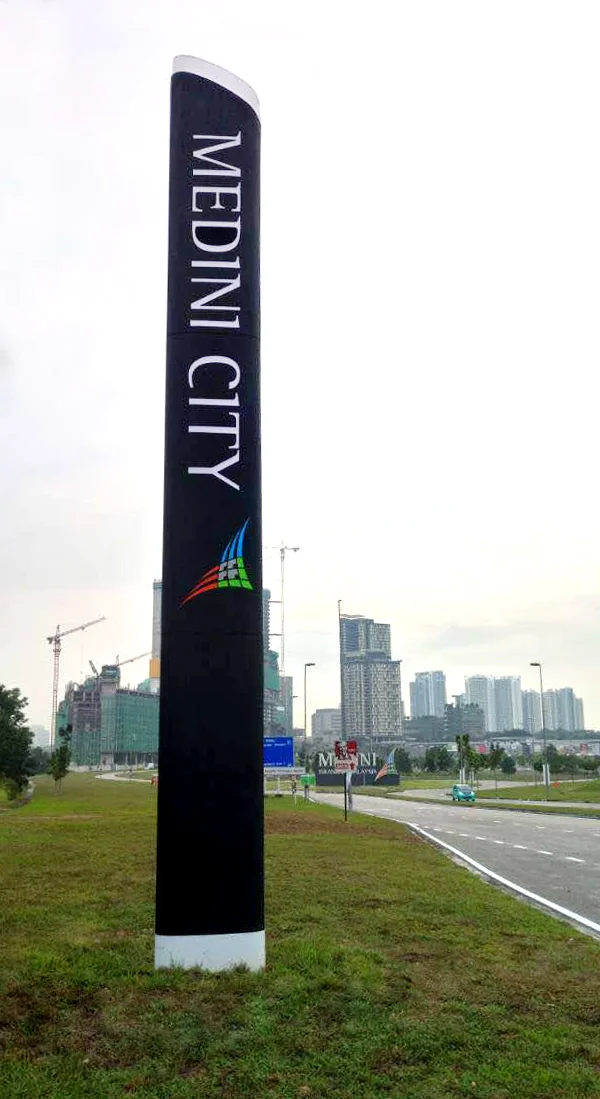Project / Medini City-wide Signage System, Johor
Task / Wayfinding & Signage
Client / Medini Iskandar Malaysia
Year/ 2016–2017; Implementation 2017–2018
Advisor / Michel de Boer (MdB Associates)
Medini is a new smart city township in Iskandar Puteri (formerly known as Nusajaya), the largest urban integrated development in Southeast Asia.
Medini currently has a sparse population, with the city largely under construction. However, the infrastructure (highways and roads) has been completed, and we could undertake the wayfinding study, as well as fabricate and install all street signs.
Our signage programme covers a network of main roads and streets spread across 2,300 acres (9.3 sq km), and comprises a comprehensive system of sign types including vehicular, pedestrian, directional, destination, identification, gantry and totem signs.
Many signs will remain on paper (with technical specifications), e.g. building sign, digital street directory, etc., until the number of buildings and facilities, and the working population in the new city increases*.
*Medini’s population is expected to grow to 450,000 by 2030.
“In many signage projects, signs are purely functional. They direct you to a destination and do nothing more. In other projects, the signs go beyond providing directions and take on a more powerful role—to communicate a sense of place and identity.
We always strive to design a signage system that enriches the physical environment, aesthetically and culturally, and to reflect the aspirations and spirit of the place.”
TOP LEFT: Map of Medini—a vision of the future. As of 2017, there are two completed office buildings in the central district, plus Legoland and a Wellness township in the northern sector. Many condominiums and retail spaces are currently under construction.
TOP RIGHT: Our design team created several digital prototypes for the city’s signs.
The Medini logo was designed in 2008 by Y&R Malaysia. We had to incorporate the logo into our signs.
Concept
Taking a cue from the rationale of the Medini logo, as well as the aspirations of a smart city, we created a motif based on the following:
Connectivity, networking
Convergence of peoples and cultures, nature and technology
Interchange, meeting points, bridging
Eco-system
The motif was applied to all the signs: internally illuminated for totem signs, and non-illuminated acid-etched for street poles.
The totem sign which marks several entryway into Medini is capped with a light ‘beacon’ visible from afar. The other side of the totem reads ‘Selamat Jalan’, Bahasa Malaysia (Malay) for ‘have a safe ride or journey’.
Colour
JKR (Public Works Dept) recommends only two background colours for street signs—white or blue. Other colours have been reserved for specific use, e.g. green for highways, brown for places of cultural or historic importance, or tourist attractions, etc.
Since Medini uses black in other applications of their identity, the black text and white background version (shown below, left) would have been ideal for their street signs. However, the signs with blue background is friendlier in terms of maintenance as white does not hold well in tropical weather.
TYPOGRAPHY
The Roman typeface
The Malay language has long words, and in Medini's case, long addresses which cannot be shortened, e.g. ‘Jalan Medini Sentral 1, 2’. This poses a readability problem as well as a material problem, resulting in the blade of the pole sign being too long.
While condensed typefaces can be a potential solution, it is also difficult to read. As such, the ideal font weight would fall between condensed and regular. This conundrum was solved with a new typeface, Wayfinding Sans by Ralf Herrmann, a clean and modern sans serif type family that does not compromise on any aspect of legibility and has been rigorously tested through computer simulation for legibility under difficult reading conditions (e.g. distance, haze, halation and positive/negative contrast).
The Jawi script
Most ‘modern’ Arabic fonts in use were designed in the 80s and 90s. DIN Next Arabic (inspired by DIN 1451, the standard typeface used in German street signs, house numbers and transportation systems) is part of a movement to modernise the script while keeping with contemporary standards of sign system typefaces (modern, legible, versatile).
An alternative was to use a more traditional script (below, right), and this was eventually selected by the client for use on all Medini signs.
UNIQUE OVAL-SHAPED POLE
The pole sign is custom designed for Medini, with an oval curve to it that gives visitors a different view from different angles: thicker from the front, thinner from the sides. This subtle visual change gives the pole an impression of both strength and elegance.
Pole signs on secondary roads: the sign panel usually has two faces, both containing the name of the road or location.
Pole signs on main roads: these signs are larger than those on secondary roads and usually have only one face containing the name of the road or the location. The back of the sign panel has a bracket that incorporates the lettering ‘Medini’. This is an important branding device for the city as several parcels of land have been bought by major developers, who may develop their own signage system within their boundaries. By advising them to incorporate our bracket design as part of their system, we will be able to inject some form of uniformity into the city's overall signage system.
As visitors leave the City of Medini, the City Boundary Marker also acts as a token of farewell, with the phrase ‘Selamat Jalan’ etched on it. This is the Malay equivalent to ‘have a safe trip’, a send-off phrase that also denotes well wishes.
Signage fabricator: Century Advertising (Johor)
“The signs in Phase 1 (street signs) and 2 (main road signs and boundary markers) have been installed. The new city is still sparsely populated, and other phases will follow as the city develops.
The design templates have been handed over to the client, and new signs will be designed by the Medini project team following our blueprint and master templates.”

















